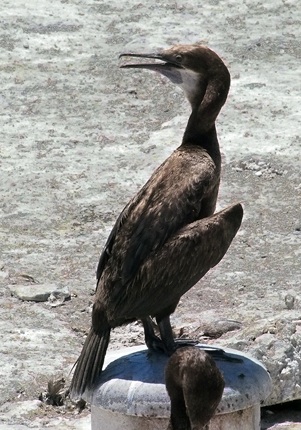A practical guide to bird watching in Sonoma County, California
(Unless otherwise indicated, all phone numbers are in the 707 area code)
A practical guide to bird watching in Sonoma County, California
(Unless otherwise indicated, all phone numbers are in the 707 area code)


One of those birds that seems particularly inappropriately named if you're used to seeing it in Sonoma County. Double-crested Cormorant has crests on either side of its head only when in breeding plumage (photo below). Normally the birds we see are in non-breeding plumage, like the bird above, although the bird shown above is puffing out its throat, giving it a somewhat uncharacteristic profile. What is characteristic in the above photo is the orange-yellow around the bird's mouth; the hooked bill; the blue-black color (note that the patterning on the back is usually less visible; in most lights Double-crested Cormorant appears fairly uniformly blackish); the short, brush-like tail; and the fact that the bird is perched in a tree. Double-crested Cormorant may be found at the coast, but also along lakes and rivers inland. Juveniles (see below) are brownish and pale at the breast and throat (sometimes light brown, sometimes almost cream-colored there).

Three species of cormorant are normally present in Sonoma County--Double-crested Cormorant, Brandt's Cormorant (Phalacrocorax penicillatus), and Pelagic Cormorant (Phalacrocorax pelagicus); only Double-crested cormorant is likely to be found inland and perched in a tree. Brandt's and Pelagic Cormorant are exclusively coastal species. The three species can be found together fairly reliably at the mouth of the Russian River. The National Geographic Field Guide to the Birds of North America notes that the crests that appear in breeding plumage are usually white or near-white in birds in the Western states but black and less obvious in birds found in the East. Double-crested Cormorant flies with a characteristic kink in the neck less conspicuous in both Brandt's and Pelagic, which fly with their necks held straight. Brandt's Cormorant has a pale beige to white throat patch that acquires a blue segment in breeding plumage (photo below). Pelagic Cormorant, meanwhile, is the smallest and most slender of the three species and has a notably thin bill without the bulge and hook at the end that both Double-crested Cormorant and Brandt's Cormorant show. The entire head of Pelagic Cormorant looks small when seen beside Brandt's. Pelagic Cormorant also develops white patches at the flanks in breeding plumage that make it very easy to spot, especially in flight. In breeding plumage, Pelagic Cormorant will have red at the base of the bill.
Swimming cormorants are often confused with loons at a distance because they swim similarly low in the water and typically with their heads held up, which may suggest Red-throated Loon (Gavia stellata) in particular.
Further reading:
Bolander and Parmeter, Birds of Sonoma County California, rev. ed., 2000, p. 22
Brinkley, National Wildlife Federation Field Guide to Birds of North America, 2007, pp. 85, 92
Burridge, ed., Sonoma County Breeding Bird Atlas, 1995, p. 26
Dunn and Alderfer, eds., National Geographic Field Guide to the Birds of North America, 5th ed., 2006, p. 106
Dunn and Alderfer, eds., National Geographic Field Guide to the Birds of North America, 6th ed., 2011, p. 106
Dunne, Pete Dunne’s Essential Field Guide Companion, 2006, pp. 119-120
Ehrlich, Dobkin, and Wheye, The Birder's Handbook, paperback edition, 1988, p. 26
Fix and Bezener, Birds of Northern California, 2000, p. 58
Floyd, Smithsonian Field Guide to the Birds of North America, 2008, p. 100
Kaufman, Field Guide to Birds of North America, 2000, p. 68
Lukas, Bay Area Birds: From Sonoma County to Monterey Bay, 2012, pp. 51-52, 55
Parmeter and Wight, Birds of Sonoma County California, Update (2000-2010), 2012, p. 17
Peterson, Birds of Eastern and Central North America, 5th ed., 2002, p. 42
Peterson, Field Guide to Birds of Western North America, 4th ed., 2010, p. 80
Peterson, Western Birds, 3rd ed., 1990, p. 28
Sibley, Field Guide to Birds of Western North America,1st ed., 2003, p. 53
Stokes, Stokes Field Guide to the Birds of North America, 1st ed., 2010, p. 115
Vuilleumier, American Museum of Natural History, Birds of North America: Western Region, 2011, p. 100
Voice: Cornell Lab of Ornithology: All About Birds--Double-crested Cormorant
© Colin Talcroft, 2009, 2010, 2011, 2012, 2013, 2014
Unless noted, all photos by the author. If you would like to use one of my images, please ask for permission for non-commercial use with proper credit or commercial use with proper compensation.


Double-crested Cormorant in full breeding plumage: The only time the bird lives up to its name: Note plumes (crests) on either side of the head, bright blue mouth and eye.
Lake Ralphine, Santa Rosa, May 19, 2011

Juvenile Double-crested Cormorant: Note pale color, yellow extending to the lores and around the greenish eye. Also note the typical cormorant swimming posture--low in the water, head held tilted up

For Comparison: Pelagic Cormorant (non-breeding plumage):
Note the small, roundish head and the straight, thin,
dark bill with no hook

Double-crested Cormorant in full breeding plumage.
Note the crests, the purplish-blue orbital ring,
and the bright blue lining of the mouth.
Lake Ralphine, Santa Rosa, May 19, 2011

Young Double-crested Cormorant.
Note the pale breast and neck color.
Lake Ralphine, Santa Rosa, December 5, 2011

Double-crested Cormorant drying its wings. Spring Lake, Santa Rosa, September 23, 2012

Double-crested Cormorant
Phalacrocorax auritus
Double-crested Cormorant, Lake Ralphine, Santa Rosa, May 19, 2011
1990-2013 Sonoma County data. Graph provided by eBird (www.ebird.org), generated June 29, 2013
EBird reported occurrence in Sonoma County


For Comparison: Brandt’s Cormorant flight silhouette

For Comparison: Brandt’s Cormorant
Santa Cruz County, May 26, 2014